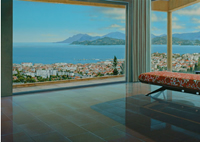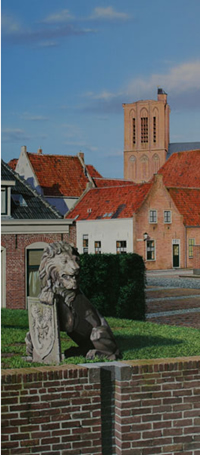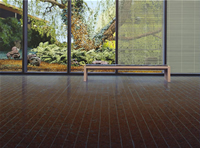|



|
Media - Acrylics
Email - [email protected]
Website - www.willemvanveldhuizen.com
Willem van Veldhuizen (1954)
'It might sound strange, but the first time I experienced a tremendous shock of recognition, I
was at a commemoration exhibition of Mark Rothko (1903 - 1970). Eventhough my work did not
develop in the direction of this kind of abstract expressionism, still it was Rothko's work
that gave me the impulse to go my own way. I saw that it was possible to decide on my own
manner in the art of painting'. What struck Willem van Veldhuizen in Rothko's work was the
search for balance on a flat surface, the appeal of a large coloured area as well as the
vibration of colours on such a large canvas.
In his paintings, this fascination is translated in large floor areas of museum interiors.
Museums provide Willem with the right kind of rooms: they are prestigious and attentive to
architecture while at the same time subservient to accommodate art. It is not that he
literally copies the rooms, but by choosing a different composition he creates fictional
spaces and alters the view to complement and intensify the image.
By visiting various modern museums, he is offered the motive for a new painting. 'When I'm
standing in such a room, I'm impressed by the atmosphere, the peace, the coolness of it all,
it strikes me emotionally. I put out my feelers as I wonder how I can shape these emotions. As
it takes form in my head, the process of translating an emotional concept into a rational
solution begins. The attraction towards the subject is purely emotional. The translation into
a painting however is a rational process.'
Technique
In general Van Veldhuizen's paintings are composed according to an established pattern. The
upper, narrow part of the canvas shows the back wall or a glass wall through which a garden is
visible. A large floor area holds a prominent place. The reality of the building or the world
outside is reflected in the floors. The back part is painted with great precision; this is
also the first part to be completed.
Then the artist builds up the floor area according to a special technique which he has made
his own. After the undercoat has been applied and the shadows have been put in, he 'splats'
the paint against the canvas: colour over colour, layer on top of layer - making subtle
distinctions in light and dark against the back wall. (Parts that should not be splat, are
covered with tape.) Van Veldhuizen uses this technique in such a way that the paint splats
onto the canvas in elliptical drops. This is highly important to create the perspective
effect. (During the final strokes, the tiles become visible). Finally the artist applies
approximately 40 layers of glaze onto the floor area to create this typical glossy three
dimensional effect.
Discipline and great technical skills are required for the kind of paintings that Van
Veldhuizen makes. Because of this method, it takes up to 3 or 4 months to finish a painting.
Van Veldhuizen mastered this technique by self-tuition. Furthermore he (made a close study of)
submitted the paintings of Peter Blake, one of England's best-known pop art artists, to a
profound study. According to Van Veldhuizen, Peter Blake displays a fabulous technique.
Influences of classical- and classic-modern masters (beside Rothko) can be recognized in his
work in various ways. He relates to Saenredam with his preference for sacred rooms,
tranquility and colours in harmonizing tones. In his museum interiors, Van Veldhuizen quotes
with pleasure his favorites in art, among others Michelangelo, Picasso, Man Ray, Newman,
Rietveld and Le Corbusier.
In his early work, the colours are kept restraint by putting various light tones in delicate
distinctions in order to achieve a balance in beauty and tranquility. His recent work is
characterized by a more expressive use of colour although the colour is still subsidiary to
the form. Also the interior itself contains less details. Still the balance between the inside
and outside world holds the key to Van Veldhuizen's paintings.
|
